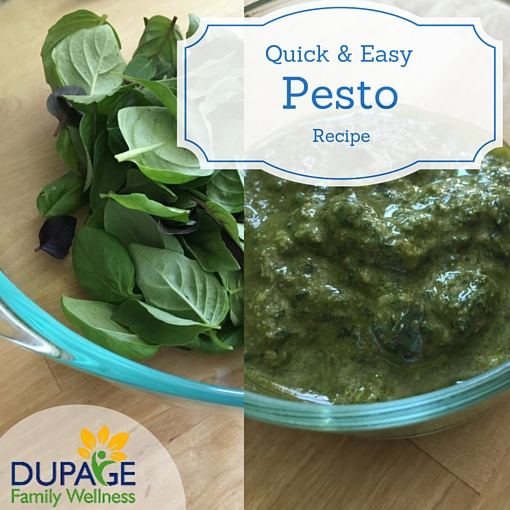 One of my goals this summer is to keep up with harvesting, so that I reap all of the benefits of our small, backyard garden. We planted quite a bit of basil and it is already big enough to harvest. I have learned that the more leaves you pick, the more they grow. You can harvest it many times - learn more about growing and harvesting basil.
One of my goals this summer is to keep up with harvesting, so that I reap all of the benefits of our small, backyard garden. We planted quite a bit of basil and it is already big enough to harvest. I have learned that the more leaves you pick, the more they grow. You can harvest it many times - learn more about growing and harvesting basil.
What is the best way to use an abundance of basil? Make pesto, of course!
An awesome benefit to cooking with herbs is that you get an abundance of the green vegetable color profile in a different way than your typical salad or broccoli side dish. Pesto is a delicious topping for chicken, fish, spaghetti squash, or spiralated zucchini.
This is a quick and easy pesto sauce, using ingredients that you probably have on hand. Make double or even bigger batches when basil is plentiful. The pesto freezes well and I love having the fresh garden taste during the winter. Freeze in ice cube or small muffin cups. Once frozen, empty them into another container and keep in the freezer until needed.
Simple Pesto
Yield: ½ cup pesto
Ingredients:
- 1 cup of packed basil leaves
- ¼ cup of walnuts (pine nuts, cashews, or another kind of nut works well too)
- 1-2 chipped garlic cloves
- ¼ cup extra virgin olive oil
- Salt and pepper to taste
Directions:
In a food processor combine basil, walnuts and spices until blended thoroughly. Pour in olive oil and blend again until mixture has reached desired consistency.
Store in refrigerator for up to one week or freeze for later use.
Enjoy!
Article by: Joelle Kurczodyna, NTP
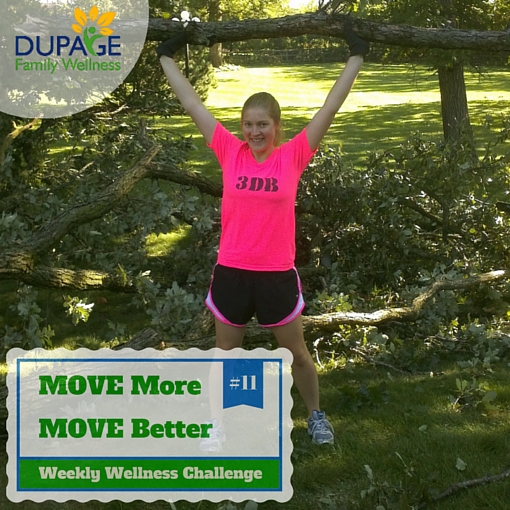 Move More - Move Better
Move More - Move Better
I saw an Instagram post earlier this week (follow me @docjthomure ) that resonated with me. The poster was Dallas Hartwig, one of the creators of the Whole 30 program where you eat real unprocessed foods for 30 days. Dallas discussed his movement while growing up. It included working in the family garden, traveling to the mountains to hike, mountain biking, canoeing, and swimming. His life was full of healthy movement, in spite of the fact that it did not include any planned or structured "exercise".
Dallas pointed out that “health is not dependent on doing tons of hard, structured exercise, and in a lot of cases hard training actually DECREASES health.” This idea has been trending in other research as well.
Many lean, fit, and muscular people have health problems that include gut issues, insomnia, fatigue, anxiety, chronic inflammation, thyroid problems, or depression. These people chase “fitness” with an intense structured exercise regimen, but it often leads to decreased health. I would rather be "healthy", meaning free of disease or injury, than have 6 pack abs that look good in the mirror, but are accompanied by underlying health conditions.
The Copenhagen City Heart Study explores the relationship between jogging and all cause mortality. They found that light and moderate joggers had lower mortality than sedentary people, but strenuous joggers had the same mortality rate as sedentary non-joggers.
Movement is an important component of overall health. People that move more throughout the day in functional ways will be healthier than those that go to the gym and beat themselves up with a repetitive workout for 45 minutes (especially if their one bout of movement is sandwiched between a desk job and an evening in front of the TV). These days, a desk job can be unavoidable. If this is your reality, walk, do squats, take the stairs, get a standing desk, and leave your desk as much as possible throughout your work day.
What are healthy functional movements?
Move more like your ancestors used to move! Just like we've discussed eating like our ancestors, we should also move like them. Functional movements will you help you to improve strength, improve mobility, and improve stability. For example:
- Walk
- Pick up something heavy and carry it
- Plant a garden and tend to it (squat)
- Climb a tree
- Build something
- Chase something
- Swim
- Paddle a boat
- Ride a bicycle
- Dance
- Play with your kids- or just act like a kid!
While this advice may seem unconventional, it is your challenge this week. Add healthy functional movement to your life each day. If you spend as much time moving as our ancestors used to (and by default less time at a desk/on a computer/watching TV, etc.) - it will lead to better health!
Dr, Jamie Thomure
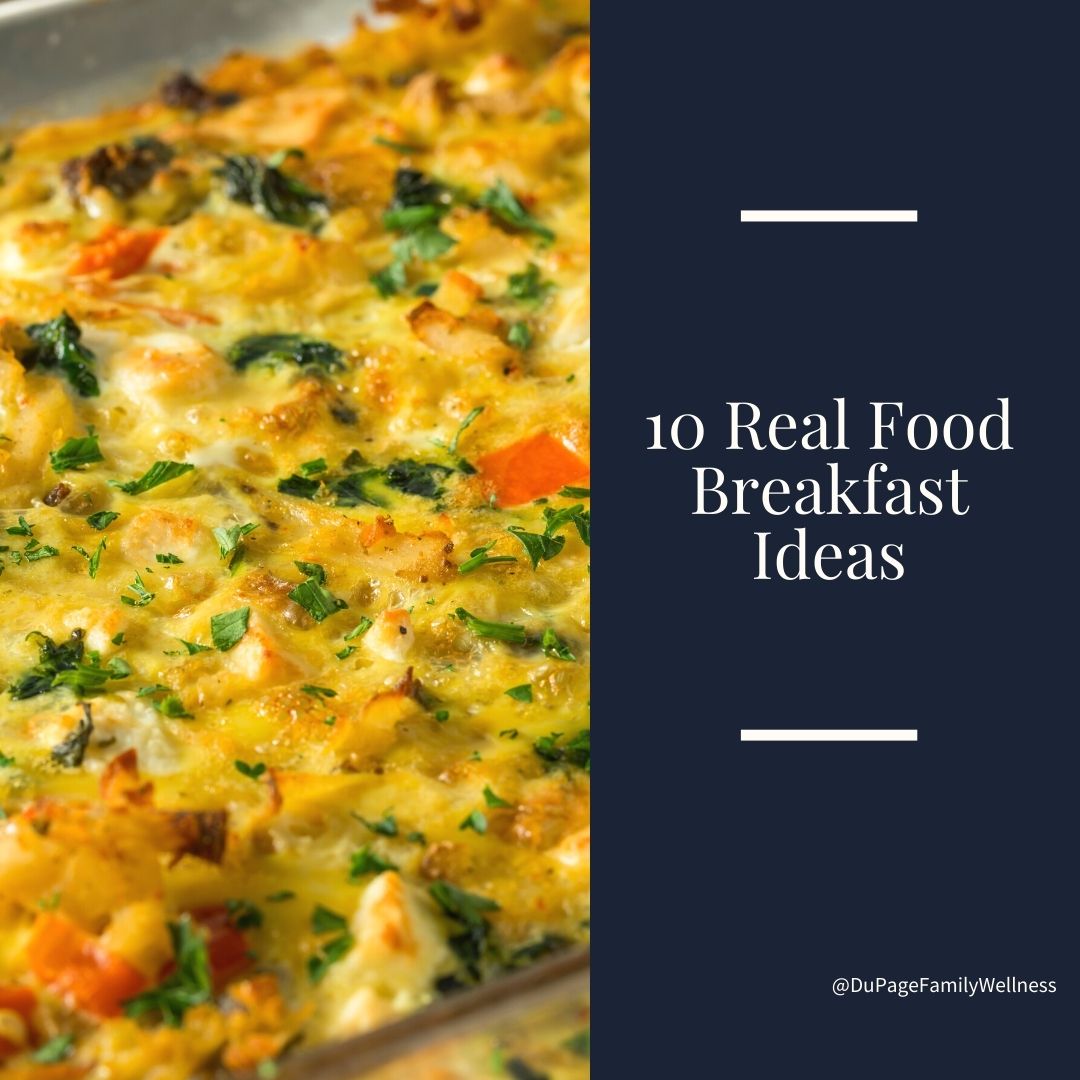 Once you decide to eat real, unprocessed foods, breakfast can be a roadblock. Most people are pressed for time in the morning but still want a quick and easy, yet satisfying breakfast. In light of this, people routinely turn to milk and cereal as a quick option. Keep reading for some better ideas.
Once you decide to eat real, unprocessed foods, breakfast can be a roadblock. Most people are pressed for time in the morning but still want a quick and easy, yet satisfying breakfast. In light of this, people routinely turn to milk and cereal as a quick option. Keep reading for some better ideas.
What’s wrong with cereal and milk?
There are 2 big reasons to avoid the standard milk and cereal breakfast.
- Cereal is not a "real food". Read the ingredient label on any cereal box, even the whole grain and organic varieties. The list usually includes some form of added sugar, along with 20-30 ingredients, many of which you cannot pronounce.
- Cereal is primarily carbohydrates, which your body converts to glucose (sugar). This is a quick burning source of fuel that gives you a surge of energy, but it only lasts for a couple of hours and then you are starving and tired again. You might find yourself heading to the break room for more coffee and a pastry. To avoid that crash, breakfast should include long-burning fuel sources provided by proteins and fats. This will keep you satisfied until lunch.
What About Oatmeal?
Steel cut or old-fashioned oatmeal passes the "real food" test, but it is a "filler" like rice or potatoes, that contains mostly carbohydrates (56 grams in a cup), and not many other nutrients. Although oatmeal is better than processed cereal, you may find that it does not have the fat and protein to keep you satisfied all morning. Read more about the pros and cons of oats.
The flavored oatmeal that comes pre-packaged in single servings is NOT real food. It contains many artificial ingredients, and added sugars just like other pre-processed cereals.
What About Eggs?
Traditionally, the recommendation has been to avoid eggs to keep your cholesterol down. Eggs have gotten a bad rap, but that is being reversed by current research. See Dr. Thomure's explanation of why you do not need to fear eggs.
Top 10 real food breakfast ideas:
10) Leftovers from the night before. While unconventional having soup or leftover meat & vegetables for breakfast is a good way to start the day.
9) Two-ingredient Banana and Egg Pancakes. (A quicker method that makes a custard-like concoction is to microwave the same ingredients. Mix the 2 eggs and 1 banana in a microwave-safe bowl. Cook for 1 minute on high power. Stir, mixing the cooked edges into the mixture. Cook for 2 additional minutes on power 5. Serve with butter and top with blueberries or strawberries. Yum!)
8) Ham and Egg Breakfast Cups - a super simple and delicious breakfast idea.
7) Breakfast Smoothie
6) Breakfast Skillet topped with an egg. (My favorite combo is sweet potato, spinach, onions, and a granny smith apple.) When the skillet is almost cooked, break one or more eggs on top and cover as it finishes cooking.
5) Full fat, PLAIN yogurt topped with fruit and nuts. You can even make easily make your own yogurt!
4) Avocado Egg Cups - a great way to incorporate healthy fats to keep you going all morning
3) My favorite Banana Bread or Muffins. Top with butter or nut butter to make it more filling.
2) Homemade Energy Bars - Make ahead for a grab-and-go breakfast.
1) Egg Casserole. This is our standard breakfast. I make it at the beginning of the week. I love it because it’s quick to reheat and an easy way to get eggs and veggies in the morning!
What are your favorite real food breakfasts?
Joelle Kurczodyna, NTP
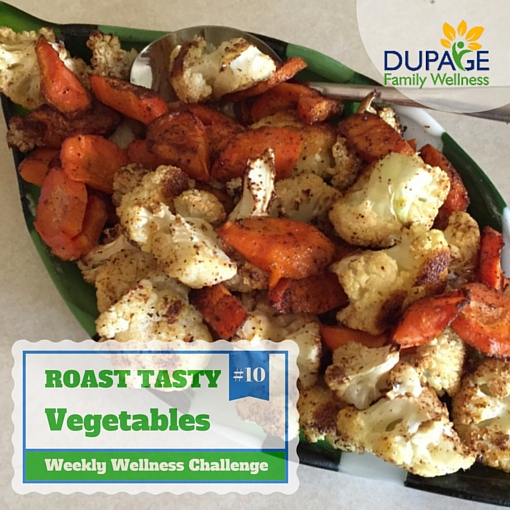 Until about 4 years ago I didn’t eat vegetables. Period. I was convinced that vegetables didn’t taste good. Now I love vegetables. Just this afternoon I had brussels sprouts as an afternoon snack. Delicious!
Until about 4 years ago I didn’t eat vegetables. Period. I was convinced that vegetables didn’t taste good. Now I love vegetables. Just this afternoon I had brussels sprouts as an afternoon snack. Delicious!
So what changed?
I learned how to cook vegetables so that they taste good!
Keep reading for the basic method of roasting vegetables that changed my life. I roasted vegetables for my picky husband and my dad, and now they enjoy eating vegetables too.
They key to making vegetables that taste good is the use of fat. Not only does the fat make the vegetables taste delicious, it is good for you. Check out this article that explains how eating vegetables with fat enables your body to better absorb the fat soluble vitamins. Patients often tell me about their bland boiled or steamed vegetables, and I remind them not to be afraid of fat.
Simple and Delicious Roasted Vegetables
Ingredients
- Vegetable(s) of choice – our favorites include broccoli, carrots, brussels sprouts, cauliflower, asparagus and sweet potato. You can also try eggplant, acorn squash, butternut squash, fennel, beets, onions, turnips, parsnips, and more!
- 1-2 tbsp of fat of choice – coconut oil, butter, ghee, or animal fat (e.g. lard, beef tallow)
- Salt and pepper to taste
Directions
- Preheat oven to 425. Spoon fat onto 9x13 glass pan or cookie sheet with rimmed edges. Place pan in the oven to melt fat.
- Cut vegetables into uniform pieces (i.e. florets, match sticks, cubes etc).
- Mix vegetables in the melted fat and season with salt and pepper. Make sure vegetables are in a single layer on pan.
- Roast vegetables in oven. Cooking time varies based on the vegetable. For heartier vegetables like broccoli, cauliflower, carrots, and sweet potatoes cook for 25-30 minutes. Asparagus is 15-20 depending on the thickness. Look for the vegetables to soften (tender when forked) and start to brown on the edges.
- Remove pan from oven and let veggies rest for 5-10 minutes in hot pan. This helps them to crisp up a bit. If you want to make it really tasty, and you tolerate dairy well, serve with butter.
More ideas:
- This technique can be used with frozen vegetables. However, in my opinion the texture is not quite as good.
- Mix 2 types of veggies that cook the same length of time (e.g. carrots and cauliflower or broccoli).
- Once you start to enjoy vegetables, it becomes easy to substitute grilled or roasted vegetables for the fries in a restaurant. Soon you will realize that the vegetables have more flavor than the fries.
- Experiment with seasonings. For example, give the vegetables "kick" by dusting with chili power and cumin, and adding a shake of cinnamon and red pepper before you mix the vegetables with the fat.
- For particularly picky eaters, if they tolerate cheese, grate some over the veggies when you remove them from the oven.
Your Challenge: Try roasting a new vegetable this week.
We’d love to hear from you. What did you try? Do you have other easy ways to prepare vegetables that taste good?
Article by: Joelle Kurczodyna, NTP
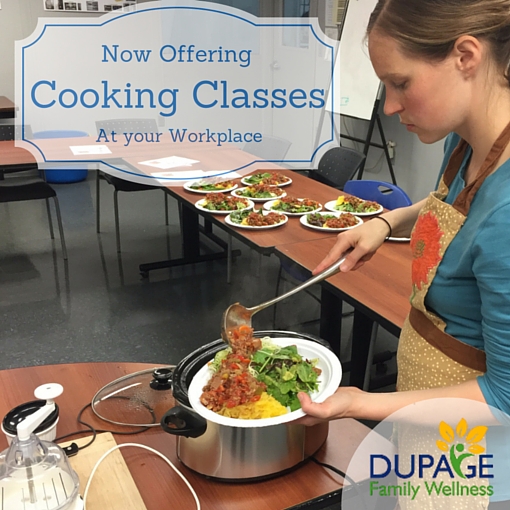
If you have been paying attention, you know that we at DuPage Family Wellness are passionate about nutrition and helping people to eat REAL FOOD!! I am excited to announce that we are offering a NEW SERVICE to help spread this message to more people in the community!!
Healthy cooking classes for businesses and corporations are now available! These classes are fun and a great fit into a corporate wellness program.
How does it work? We come to your workplace and bring a healthy lunch. While you and your coworkers eat this nutritious and delicious meal, we demonstrate various components of how the lunch was prepared. You will learn WHY we are eating the food we are, and the benefits of incorporating our REAL FOOD principles!
Classes can be as short as 30 minutes over lunch, or longer depending on your workplace needs. Topics and menus can be customized. It can be a single event or a series of classes. Our most recent class consisted of two 30 minute sessions with 12 employees at each.
Don't have a kitchen? Don't worry, we can improvise! As long as there are tables and chairs, we can make it work!
Eating real food not only has health benefits, but it has been shown to improve mood! What company wouldn't want happier and healthier employees! If your company is looking for a new fun activity for it's employees, let us know!
 One of my goals this summer is to keep up with harvesting, so that I reap all of the benefits of our small, backyard garden. We planted quite a bit of basil and it is already big enough to harvest. I have learned that the more leaves you pick, the more they grow. You can harvest it many times - learn more about growing and harvesting basil.
One of my goals this summer is to keep up with harvesting, so that I reap all of the benefits of our small, backyard garden. We planted quite a bit of basil and it is already big enough to harvest. I have learned that the more leaves you pick, the more they grow. You can harvest it many times - learn more about growing and harvesting basil.

 Move More - Move Better
Move More - Move Better Once you decide to eat real, unprocessed foods, breakfast can be a roadblock. Most people are pressed for time in the morning but still want a quick and easy, yet satisfying breakfast. In light of this, people routinely turn to milk and cereal as a quick option. Keep reading for some better ideas.
Once you decide to eat real, unprocessed foods, breakfast can be a roadblock. Most people are pressed for time in the morning but still want a quick and easy, yet satisfying breakfast. In light of this, people routinely turn to milk and cereal as a quick option. Keep reading for some better ideas. Until about 4 years ago I didn’t eat vegetables. Period. I was convinced that vegetables didn’t taste good. Now I love vegetables. Just this afternoon I had brussels sprouts as an afternoon snack. Delicious!
Until about 4 years ago I didn’t eat vegetables. Period. I was convinced that vegetables didn’t taste good. Now I love vegetables. Just this afternoon I had brussels sprouts as an afternoon snack. Delicious! 
